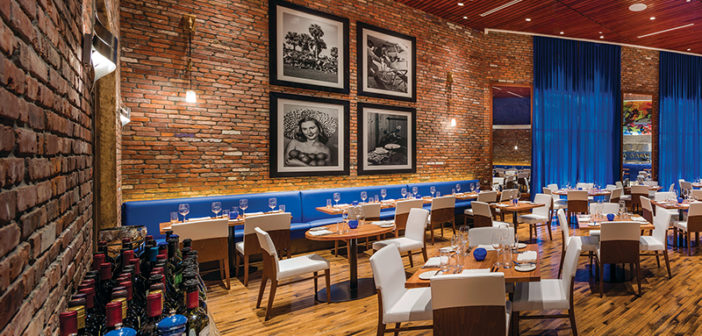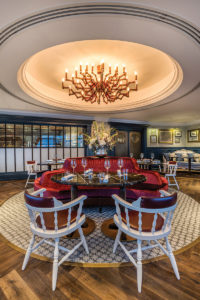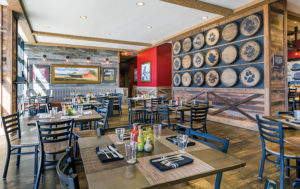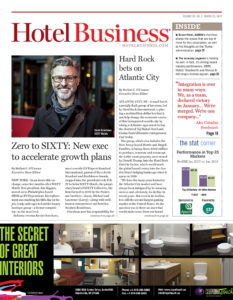A hotel’s restaurant is perhaps as integral to the property as its guestrooms, since guests and the general public will be interested in what it has to offer. For designers, it is their responsibility to either work with an owner’s or developer’s vision, or to take the initiative to create a space that stands out from other restaurants in the area, whether inside a neighboring hotel or on a nearby street.
Pat McBride, founder and CEO of The McBride Company, a Vermont-based creative concept and design firm which has recently worked on restaurant projects such as JWB Prime Steak and Seafood at Margaritaville Hollywood Beach Resort in Florida, Barnwood at Great Wolf Lodge Colorado Springs in Colorado and Margaritaville Restaurant at River Spirit Casino Resort in Tulsa, OK, noted that hotel restaurant design has changed in recent years.
“In decades past, many hotel operators used to think of their affiliated restaurants simply as a necessary amenity to satisfy hotel guests. In Manhattan and Chicago, for example, the hotel restaurants were geared to the ‘power breakfast’ and ‘power lunch’ business crowds,” he said. “What’s changed is that restaurants affiliated with hotels are now being treated more as destinations of their own—sometimes even positioned as one of the main reasons to choose to stay at that hotel. The hotel industry is coming to understand that the right bar or restaurant can really be a major draw to the overall destination.”
For Ken Lam, principal of Toronto-based Navigate Design, which recently completed the design of two restaurants in tower B of the JW Marriott Marquis Dubai, Weslodge Saloon on the 68th floor and Morah on the 71st floor, there’s one major consideration when working on a project.
“When you do a restaurant design, you always have to think of the flow,” he said. “It used to be more about having the bar and dining room separate. Nowadays, the flow is more bar-oriented. People want energy and want to dine and drink in the same space. There’s a blur between the bar area and the dining room, so that trend in restaurant themes dictates how we design.”
In many cases, hotel operators will come to the design firm with their ideas on the space, design concept and cuisine of the restaurant, some actually coming from the chef. While the designers will try to keep to that original concept, it is up to them to tweak it to make it work. This is especially true for The McBride Company, which oftentimes is designing both the hotel and the dining establishments.
“Depending on the size of the project, there are often multiple F&B venues,” said McBride, whose firm is currently designing several restaurants and bars at Margaritaville Resort Orlando in Florida. “In this case, we work closely with the developer to carve out the different types of venues that will fill certain needs and appeal to the clientele. We’ll also work with the culinary director to identify a few different concepts that feel appropriate to the vibe of the overall hotel—be it seafood, farm-to-table or something totally unique.”
He continued, “In the cases when we’re engaged solely for the restaurant, we’re usually working within parameters the developer or chef has set in terms of square footage and the approach to the dining concept.”
Lam’s firm, which is currently working on hotel restaurant projects in Calgary, Alberta, Canada, and Miami Beach, offers consultation services on how to create the most efficient restaurant, but he noted that in every project, “At the end of the day, it is their restaurant. They live and breathe there every day, and tell people about it every day. It is their product and it’s crucial for them to be involved in everything.”
He continued, “A lot of the owners that come to us have some experience in the restaurant industry, and they have a vision as to certain things. At every step of the way, it is important to involve the owner because if our knowledge doesn’t cater to their needs, there’s no business. We want them to succeed as much as we want them to work with us to make sure we meet their needs, from space planning, interior design elements, chair fabric, etc. When we come in, we can definitely fit in their ideas, but we can interject as to what we think is right. We can tweak their design and can tell them why something won’t work or what will work better.”
McBride noted there are more things to consider than what is going to be placed inside the restaurant. “When we’re engaged at the strategic planning level, we’re helping answer key questions: What type of restaurant does this city want?; What type of dining option would succeed in this hotel?; and What kind of venue would respond well to the surrounding area?” he said.
While the design of the kitchen is usually handled by specialized kitchen designers, both McBride and Lam have noticed a trend emerging—open kitchen, where patrons can see their meals being prepared.
“An open kitchen creates energy and anticipation, which can be a good thing for the restaurant environment, but only the right type of venue can execute this properly,” said McBride. “If you’re going to design a dining room around an open kitchen, you need to ensure you will consistently present a clean kitchen and a staff that knows how to play to the public.”
Lam noted that an open kitchen could just involve certain elements of the space, using as an example Weslodge, which “has a 12-ft.-long wood-burning grill that is a showcase piece,” and added, “If it is a showpiece, we will show it off. For a dessert station that will have a theatrical effect, we can create something that is more up-close and personal.”
McBride called the bar area “the spark of the restaurant where patrons first sense the camaraderie and get a peek at the dining environment,” while Lam noted that it “has become more of a multipurpose social space where you can have a cocktail and talk to the bartender, and you can also have a proper meal there.”
Moving into the dining room, both designers noted that the space needs more than just tables and chairs to make it memorable for guests. Lam said, “It’s more about what patrons can see within a two-ft. radius, and what they can touch and feel. So, when they are eating, they look at the plates, the tabletop. They look at the artwork around them. We spend a lot of time curating art and objects that we put on shelving, lighting on the tables, the type of cushions on the chairs, etc.”
“Special features need to be dynamic, but you don’t want them to be kitsch,” said McBride. “There’s not a single item that does the job in every scenario. For example, we designed a volcano stage at the Margaritaville Restaurant in the River Spirit Casino Resort, and we designed a 30-ft.-wide work of art featuring a spear fisherman in the JWB Prime Steak and Seafood. It’s always a different solution depending on what’s appropriate for the atmosphere and the intent.” HB





